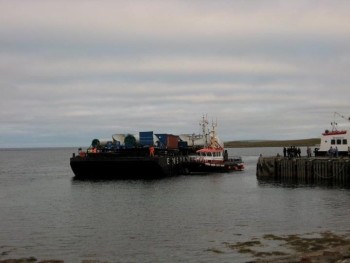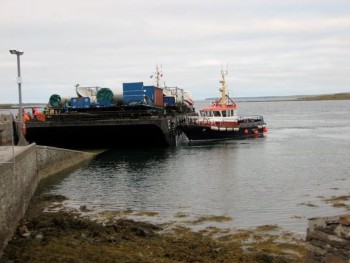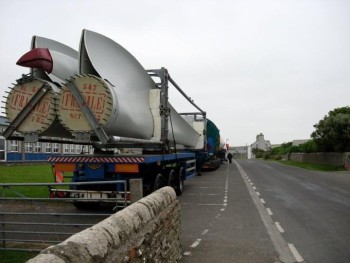Stromness Museum's 2025-26 temporary exhibition is on the theme of renewable energy in Orkney. Specifically we'll focus on the people behind all of the incredible renewable developments. Here, former Stromness Museum Trustee and former Orkney Museum Curator Sheila Garson, tells the story of the Shapinsay wind turbine.
Enercon E44, 900kW, 45m tower, blade diameter of 44m and standing 67m at its highest point. The Shapinsay turbine is named Whirly.
Back in the late 1990s and early 2000s many of Orkney’s island communities began to look at how they might better shape their own future to ensure their sustainability. Development Groups began to be formed and these were later formalised into the Development Trusts we know today.
As these Trusts grew and developed plans for what each island community saw as important for them, it became clear that they needed an income stream to help fund their aspirations. From this came the idea of the island trusts each building and operating a community owned turbine.
In 2007/8 the development trusts in Westray, Stronsay, Eday, Shapinsay, Hoy and Rousay, Egilsay and Wyre began to work towards this goal, with Westray commissioning their Enercon E44, 900kW turbine in 2009, the others following in late 2011, with Eday coming online in 2012.
While these projects were each supported by Community Energy Scotland (CES), Highlands and Islands Enterprise (HIE) and various legal and financial specialists, much of the leg work during the planning and delivery of the project was done by the volunteer directors.
In February 2008, having identified a site and undertaken an initial feasibility study, Shapinsay Development Trust (SDT) decided to hold an island wide poll to gauge the community’s support before they advanced the project. A postal vote was sent to all island residents over 16, with votes returned to Voluntary Action Orkney who counted them and collated the results. The poll saw a 76% return, with 77% voting for the project and 23% against.
Now with a strong mandate the Trust began work on the planning application and gathering all the necessary documentation. This included an Environmental Impact Assessment, Noise Assessment and Anemometry readings. Alongside this was work on securing the necessary funding for a project costing over £1.8M. This included a significant bid to the Lottery Fund and negotiating a commercial loan from the Co-op Bank. There were legal agreements to put in place with the various landowners of the site and access track, a grid connection to negotiate as well as agreements for the export of the energy.
When the SDT turbine application went to the Planning Committee in November 2008, the application attracted a number of objections, the majority of which were from England, with very few from Orkney or indeed Shapinsay. Using the poll, the Trust was able to prove the island’s strong supported for the project and challenge the validity of those who did not live in Orkney overturn the communities wishes. The application was deferred, but planning approval was subsequently secured. This delay impacted the turbine’s grid connection and eventual level of curtailment.
Another key piece of work was the establishment of an arm’s length trading company, Shapinsay Renewables Limited (SRL), to manage the turbine once it was operational. This was essential to protect the charitable status of the Trust and to ensure the turbine was operated on a commercial basis. While managed by an independent Board of volunteer Directors, SRL is wholly owned by SDT and passes it’s profits down to the Trust to be used for the benefit of the island.
In spring 2011 the years of hard work began to pay off when work began to prepare the access track and turbine site for the expected arrival of the turbine in the summer.
As Shapinsay and Rousay piers had hard ramps rather than link spans, these two turbines were transported across the North Sea by barge from Germany. It difficult to describe the thrill of seeing this sailing in past Shapinsay and more so seeing it unloaded at the island pier late one Saturday night. It was soon constructed and in October 2011 was commissioned and so began generating income for the island.
In the development phase the projected income the community could expect from the turbine was approximately £60K per annum. Since 2011 the 300 or so residents of Shapinsay have benefitted from significantly more than that amount each year. This has helped fund the out of hours ferry service, island transport initiative which now uses electric cars, Here to Help and Wellbeing projects, education and training grants for island residents and grants to local groups and organisations. The turbine income also enables the Trust to attract external funding, and it now owns and rent three family homes, operates a charity shop and the Smithy café/restaurant.
This is the story of the Shapinsay turbine, and while each of the island trusts will have a similar story, they will each have had different experiences along the way and their outcomes will have been tailored to meet the unique needs of their island.








